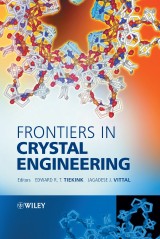Details

Frontiers in Crystal Engineering
1. Aufl.
|
232,99 € |
|
| Verlag: | Wiley |
| Format: | |
| Veröffentl.: | 01.05.2006 |
| ISBN/EAN: | 9780470022597 |
| Sprache: | englisch |
| Anzahl Seiten: | 352 |
DRM-geschütztes eBook, Sie benötigen z.B. Adobe Digital Editions und eine Adobe ID zum Lesen.
Beschreibungen
FRONTIERS IN<b> CRYSTAL ENGINEERING</b> <p>Crystal engineering – where the myriad of intermolecular forces operating in the solid-state are employed to design new nano- and functional materials – is a key new technology with implications for catalysis, pharmaceuticals, synthesis and materials science. <p><i>Frontiers in Crystal Engineering </i>gathers personal perspectives, from international specialists working in molecular aspects of crystal engineering, on the practical and theoretical challenges of the discipline, and future prospects. These demonstrate the approaches that are being used to tackle the problems associated with the complexity, design and functionality of crytalline molecular solids. <p>Topics include <ul><li>how intermolecular forces direct and sustain crystal structures</li> <li>functional engineering and design elements</li> <li>coordination polymers and network structures</li> <li>applications in green and pharmaceutical chemistry</li></ul> <p><i>Frontiers in Crystal Engineering</i> is a useful guide to this exciting new discipline for both entrants to the field as well as established practitioners, and for those working in crystallography, medicinal and pharmaceutical sciences, solid-state chemistry, and materials and nanotechnology.
<b>List of Contributors.</b> <p><b>Foreword.</b></p> <p><b>1. Applications of Crystal Engineering Strategies in Solvent-free Reactions: Toward a Supramolecular Green Chemistry.</b></p> <p>1 Introduction.</p> <p>1 Mechanochemical preparation of Hydrogen-Bonded Adducts.</p> <p>1 Mechanically induced formation of covalent bonds.</p> <p>1 The solvent-free chemistry of the zwitterion.</p> <p>1 Concluding remarks.</p> <p>1 Acknowledgements.</p> <p>References.</p> <p><b>2. Crystal Engineering of Pharmaceutical Co-crystals.</b></p> <p>1 Introduction.</p> <p>2 What is the origin of polymorphism and is it prevalent in co-crystals?.</p> <p>3 What is the pharmaceutical co-crystal?.</p> <p>4 Conclusions.</p> <p>5 Acknowledgements.</p> <p>References.</p> <p><b>3. Template-controlled Solid-state Synthesis: Toward a General Form of Covalent Capture in Molecular Solids.</b></p> <p>1 Introduction.</p> <p>2 Controlling reactivity using linear templates.</p> <p>3 Template-controlled solid-state reactivity.</p> <p>4 Target-oriented organic synthesis in the organic state.</p> <p>5 Other linear templates.</p> <p>6 Summary and outlook.</p> <p>References.</p> <p><b>4. Interplay of Non-covalent Bonds: Effect of Crystal Structure on Molecular Structure.</b></p> <p>1 Introduction.</p> <p>2 Second-sphere coordination.</p> <p>3 Soft coordination environments.</p> <p>4 Speciation.</p> <p>5 Molecular conformation.</p> <p>6 Conclusions.</p> <p>References.</p> <p><b>5. Crystal Engineering of Halogenated Heteroaromatic Clathrate Systems.</b></p> <p>1 Introduction.</p> <p>2 Aromatic edge-edge C-H...N dimers.</p> <p>3 Heteroatom-1,3-peri interactions.</p> <p>4 Molecular pen structures.</p> <p>5 Halogenated edge-edge interactions.</p> <p>6 Pi-halogen dimer (PHD) interactions.</p> <p>7 Molecular bricks, spheres and grids.</p> <p>8 Conclusions.</p> <p>9 Acknowledgements.</p> <p>References.</p> <p><b>6. Steric Control over Supramolecular Aggregation: A Design Element in Crystal Engineering?</b></p> <p>1 Introduction.</p> <p>2 Diorganotin carboxylates.</p> <p>3 Triorganotin carboxylates.</p> <p>4 Binary zinc xanthates.</p> <p>5 Bipyridine adducts of zinc dithiophosphates.</p> <p>6 Binary mercury dithiocarbamates.</p> <p>7 Binary bismuth xanthates.</p> <p>8 Conclusions and Outlook.</p> <p>9 Acknowledgements.</p> <p>References.</p> <p><b>7. Incorporating Molecular Hosts into Network Structures.</b></p> <p>1 Introduction.</p> <p>2 Hydrogen-bonded structures with CTV.</p> <p>3 Coordination polymers.</p> <p>4 Extended-arm CTV derivatives and their coordination polymers.</p> <p>5 Conclusions.</p> <p>6 Acknowledgements.</p> <p>References.</p> <p><b>8. Interpenetrating Networks.</b></p> <p>1 Introduction.</p> <p>2 Notation.</p> <p>3 1-D nets.</p> <p>4 2-D nets.</p> <p>5 3-D nets.</p> <p>6 Unusual interpenetration.</p> <p>7 Consequences of interpenetration.</p> <p>8 Self-penetration.</p> <p>9 Entangled but not interpenetrating.</p> <p>10 Conclusions.</p> <p>References.</p> <p><b>9. Architecture and Functional Engineering Based on Paddlewheel Dinuclear Tetracarboxylate Building Blocks.</b></p> <p>1 Introduction.</p> <p>2 Synthetic strategy.</p> <p>3 Architecture engineering based on preorganized building blocks.</p> <p>4 Conductive and magnetic properties based on preorganized building blocks.</p> <p>5 Porous properties based on preorganized and in situ building blocks.</p> <p>6 Conclusion and outlook.</p> <p>References.</p> <p><b>10. Supramolecular Interactions in Directing and Sustaining Coordination Molecular Architectures.</b></p> <p>1 Introduction.</p> <p>2 Molecular architectures assembled by hydrogen-bonding interactions.</p> <p>3 Molecular architectures assembled VIA ... Interactions.</p> <p>4 Metallophilic interactions.</p> <p>5 Concluding remarks and outlooks.</p> <p>6 Acknowledgements.</p> <p>References.</p> <p><b>11. The Structure-directing Influence of Hydrogen Bonding in Coordination Polymers.</b></p> <p>1 Introduction.</p> <p>2 A novel cadmium cyanide network.</p> <p>3 Dihydroxybenzoquinone and Chloranilic acid derivatives of Lanthanides.</p> <p>4 A stable zinc saccharate network.</p> <p>5 Anionic metal-carbonate networks.</p> <p>6 Conclusions.</p> <p>References.</p> <p><b>12. Hydrogen-bonded Coordination Polymeric Structures.</b></p> <p>1 Introduction.</p> <p>2 Solid-state supramolecular transformation of hydrogen-bonded 3-D network to 3-D coordination polymetric network structures by thermal dehydration.</p> <p>3 Interconvertible solid-state supramolecular transformation.</p> <p>4 Solid-state transformation of a helical coordination polymetric structure to a 3-D coordination network structure by thermal dehydration.</p> <p>5 Influence of chiral centers on the helicity of the coordination polymers.</p> <p>6 Consequences of C=O... interactions.</p> <p>7 Supramolecular isomerism.</p> <p>8 Starlike channels and hexagonal diamondoid topology.</p> <p>9 Hydrogen-bonded helical water molecules inside a staircase 1-D coordination polymer.</p> <p>10 Hydrogen-bonded polyrotaxane-like structure containing cyclic (H2O)4 in [Zn(OAc)2(m-bpe)].2H2O.</p> <p>11 Summary.</p> <p>12 Acknowledgements.</p> <p>References.</p> <p><b>Index.</b></p>
"Both entrenched and budding members of the discipline will find benefit from reading this text." (<i>Molecular Crystals & Liquid Crystals</i>, Volume 461, 2006) <p>"…a useful review of the breadth of activity and leading thinking in the field of crystal design." (<i>Journal of the American Chemical Society</i>, June 14, 2006)</p>
<p><b>Edward R. T. Tiekink</b> is the editor of Frontiers in Crystal Engineering, published by Wiley.</p> <p><b>Jagadese Vittal</b> is the editor of Frontiers in Crystal Engineering, published by Wiley
<p>Crystal engineering – where the myriad of intermolecular forces operating in the solid-state are employed to design new nano- and functional materials – is a key new technology with implications for catalysis, pharmaceuticals, synthesis and materials science.</p> <p><i>Frontiers in Crystal Engineering </i>gathers personal perspectives, from international specialists working in molecular aspects of crystal engineering, on the practical and theoretical challenges of the discipline, and future prospects. These demonstrate the approaches that are being used to tackle the problems associated with the complexity, design and functionality of crytalline molecular solids. <p>Topics include <ul><li>how intermolecular forces direct and sustain crystal structures</li> <li>functional engineering and design elements</li> <li>coordination polymers and network structures</li> <li>applications in green and pharmaceutical chemistry</li></ul> <p><i>Frontiers in Crystal Engineering</i> is a useful guide to this exciting new discipline for both entrants to the field as well as established practitioners, and for those working in crystallography, medicinal and pharmaceutical sciences, solid-state chemistry, and materials and nanotechnology.

















